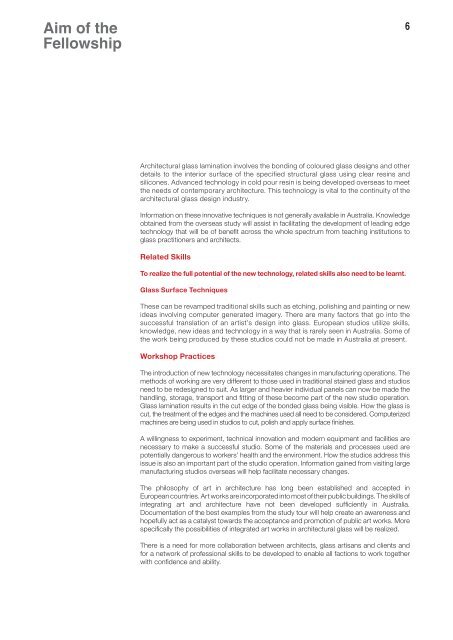contemporary techniques in architectural glass - International ...
contemporary techniques in architectural glass - International ...
contemporary techniques in architectural glass - International ...
You also want an ePaper? Increase the reach of your titles
YUMPU automatically turns print PDFs into web optimized ePapers that Google loves.
Aim of the<br />
Fellowship<br />
<br />
Architectural <strong>glass</strong> lam<strong>in</strong>ation <strong>in</strong>volves the bond<strong>in</strong>g of coloured <strong>glass</strong> designs and other<br />
details to the <strong>in</strong>terior surface of the specified structural <strong>glass</strong> us<strong>in</strong>g clear res<strong>in</strong>s and<br />
silicones. Advanced technology <strong>in</strong> cold pour res<strong>in</strong> is be<strong>in</strong>g developed overseas to meet<br />
the needs of <strong>contemporary</strong> architecture. This technology is vital to the cont<strong>in</strong>uity of the<br />
<strong>architectural</strong> <strong>glass</strong> design <strong>in</strong>dustry.<br />
Information on these <strong>in</strong>novative <strong>techniques</strong> is not generally available <strong>in</strong> Australia. Knowledge<br />
obta<strong>in</strong>ed from the overseas study will assist <strong>in</strong> facilitat<strong>in</strong>g the development of lead<strong>in</strong>g edge<br />
technology that will be of benefit across the whole spectrum from teach<strong>in</strong>g <strong>in</strong>stitutions to<br />
<strong>glass</strong> practitioners and architects.<br />
Related Skills<br />
To realize the full potential of the new technology, related skills also need to be learnt.<br />
Glass Surface Techniques<br />
These can be revamped traditional skills such as etch<strong>in</strong>g, polish<strong>in</strong>g and pa<strong>in</strong>t<strong>in</strong>g or new<br />
ideas <strong>in</strong>volv<strong>in</strong>g computer generated imagery. There are many factors that go <strong>in</strong>to the<br />
successful translation of an artist’s design <strong>in</strong>to <strong>glass</strong>. European studios utilize skills,<br />
knowledge, new ideas and technology <strong>in</strong> a way that is rarely seen <strong>in</strong> Australia. Some of<br />
the work be<strong>in</strong>g produced by these studios could not be made <strong>in</strong> Australia at present.<br />
Workshop Practices<br />
The <strong>in</strong>troduction of new technology necessitates changes <strong>in</strong> manufactur<strong>in</strong>g operations. The<br />
methods of work<strong>in</strong>g are very different to those used <strong>in</strong> traditional sta<strong>in</strong>ed <strong>glass</strong> and studios<br />
need to be redesigned to suit. As larger and heavier <strong>in</strong>dividual panels can now be made the<br />
handl<strong>in</strong>g, storage, transport and fitt<strong>in</strong>g of these become part of the new studio operation.<br />
Glass lam<strong>in</strong>ation results <strong>in</strong> the cut edge of the bonded <strong>glass</strong> be<strong>in</strong>g visible. How the <strong>glass</strong> is<br />
cut, the treatment of the edges and the mach<strong>in</strong>es used all need to be considered. Computerized<br />
mach<strong>in</strong>es are be<strong>in</strong>g used <strong>in</strong> studios to cut, polish and apply surface f<strong>in</strong>ishes.<br />
A will<strong>in</strong>gness to experiment, technical <strong>in</strong>novation and modern equipment and facilities are<br />
necessary to make a successful studio. Some of the materials and processes used are<br />
potentially dangerous to workers’ health and the environment. How the studios address this<br />
issue is also an important part of the studio operation. Information ga<strong>in</strong>ed from visit<strong>in</strong>g large<br />
manufactur<strong>in</strong>g studios overseas will help facilitate necessary changes.<br />
The philosophy of art <strong>in</strong> architecture has long been established and accepted <strong>in</strong><br />
European countries. Art works are <strong>in</strong>corporated <strong>in</strong>to most of their public build<strong>in</strong>gs. The skills of<br />
<strong>in</strong>tegrat<strong>in</strong>g art and architecture have not been developed sufficiently <strong>in</strong> Australia.<br />
Documentation of the best examples from the study tour will help create an awareness and<br />
hopefully act as a catalyst towards the acceptance and promotion of public art works. More<br />
specifically the possibilities of <strong>in</strong>tegrated art works <strong>in</strong> <strong>architectural</strong> <strong>glass</strong> will be realized.<br />
There is a need for more collaboration between architects, <strong>glass</strong> artisans and clients and<br />
for a network of professional skills to be developed to enable all factions to work together<br />
with confidence and ability.

















